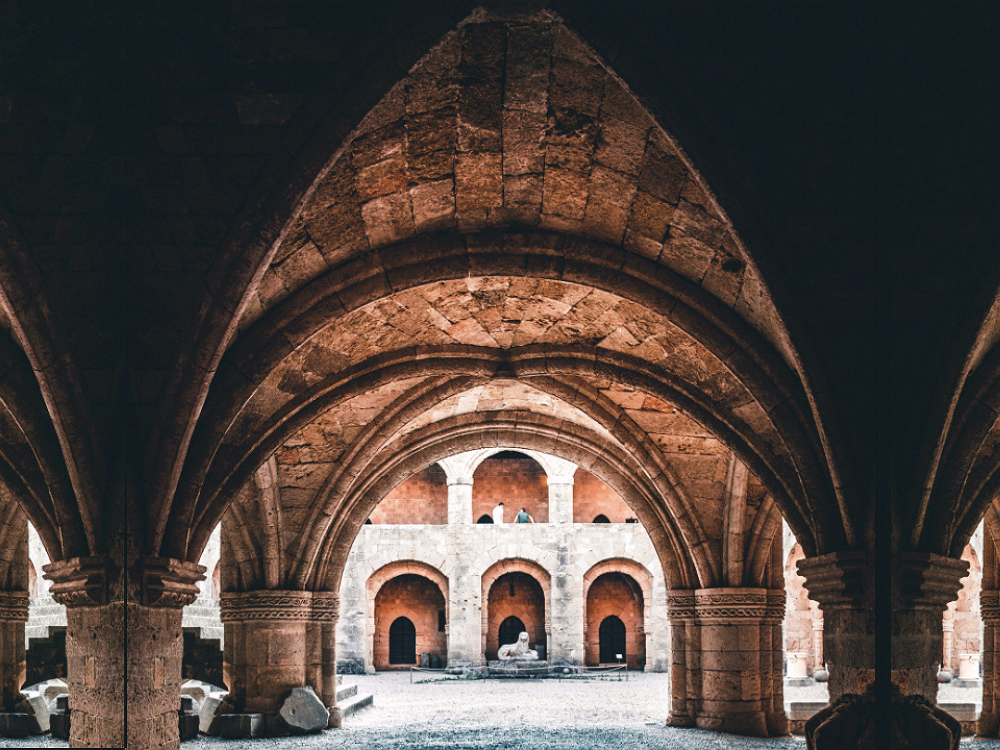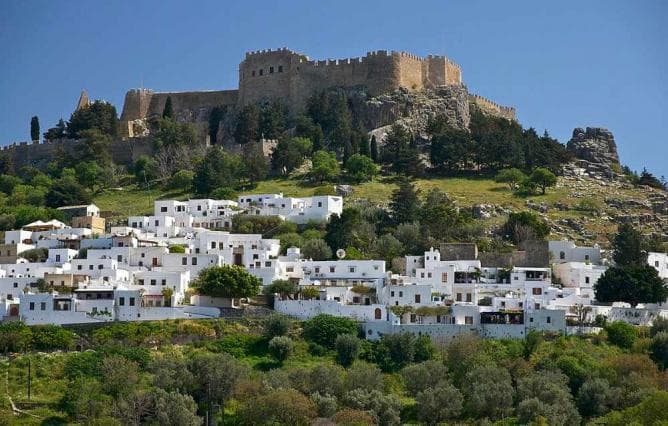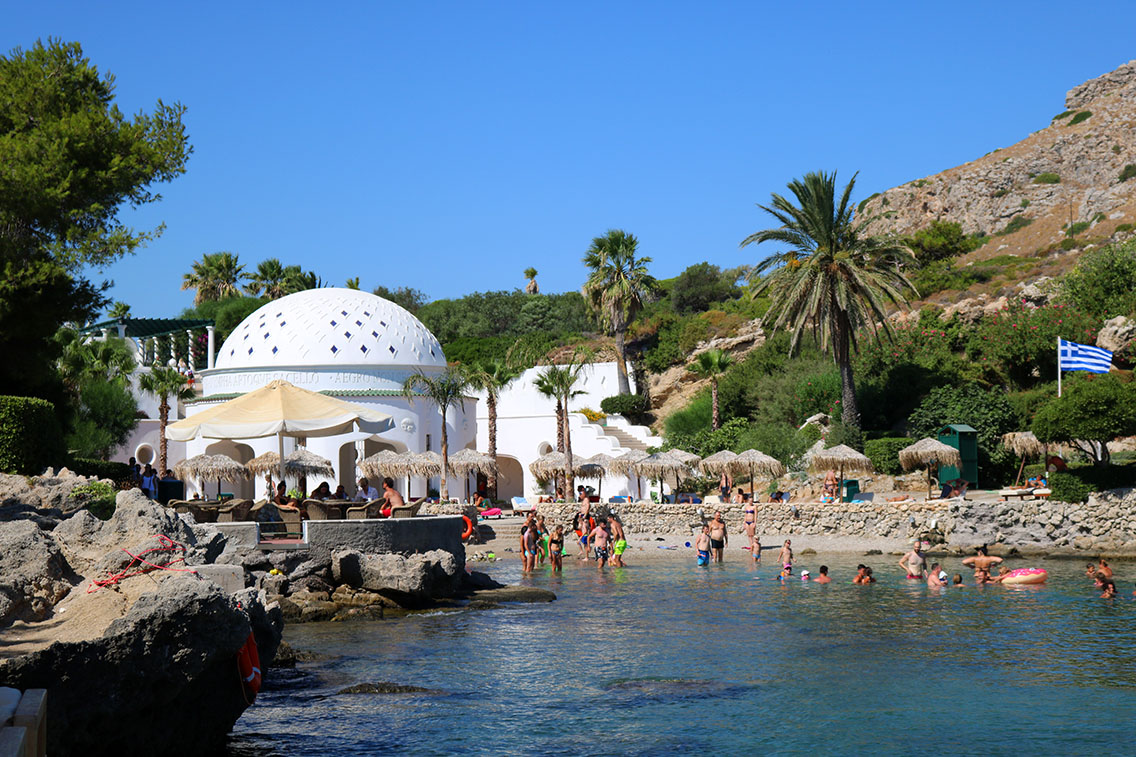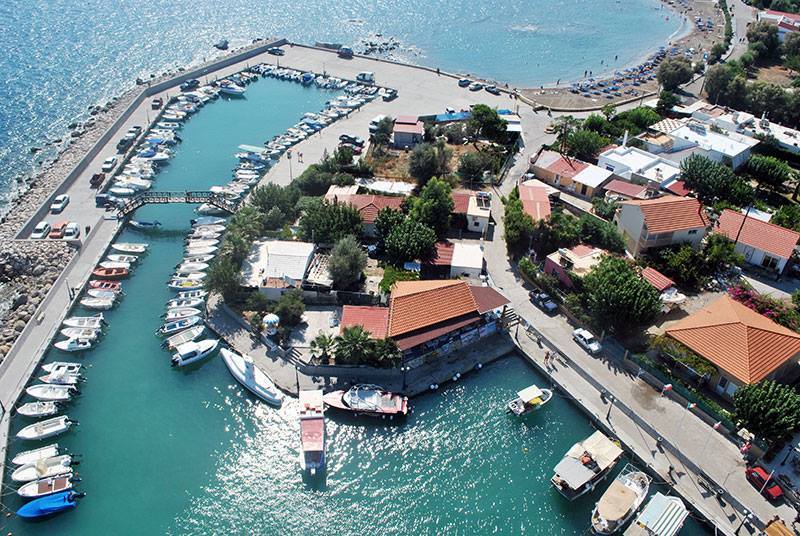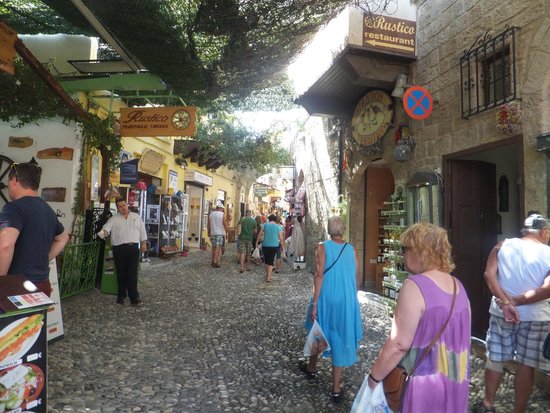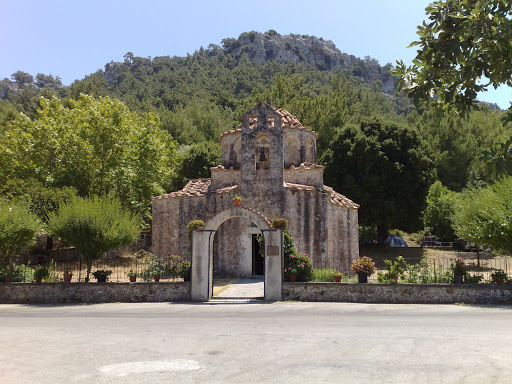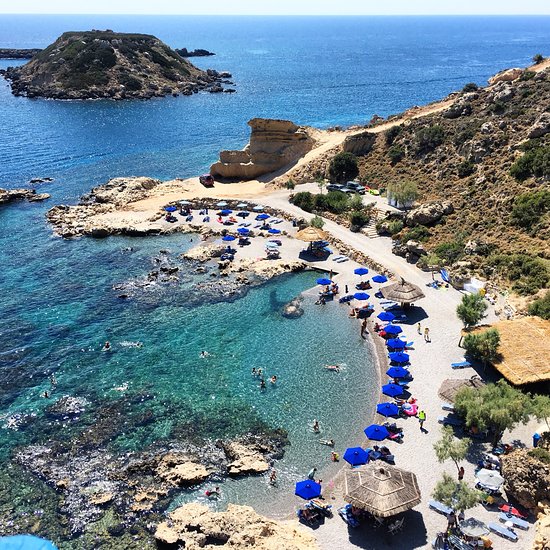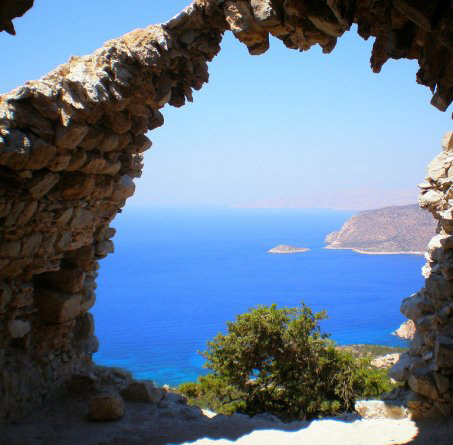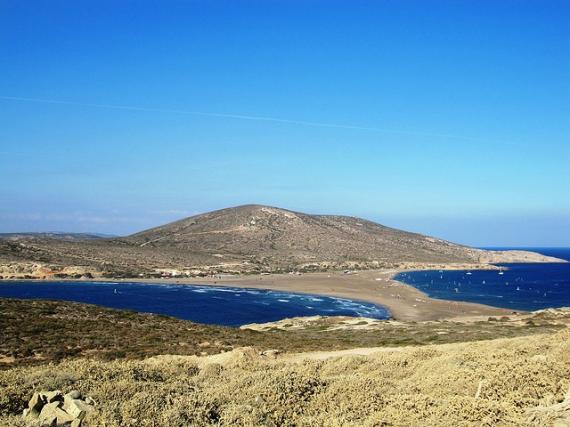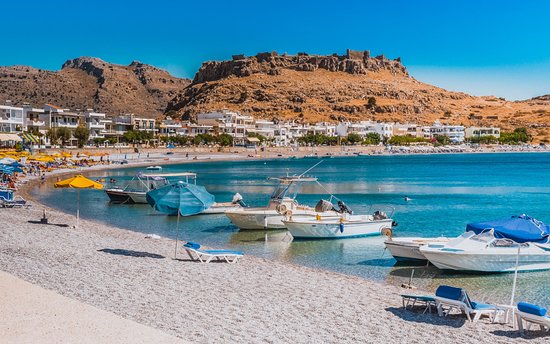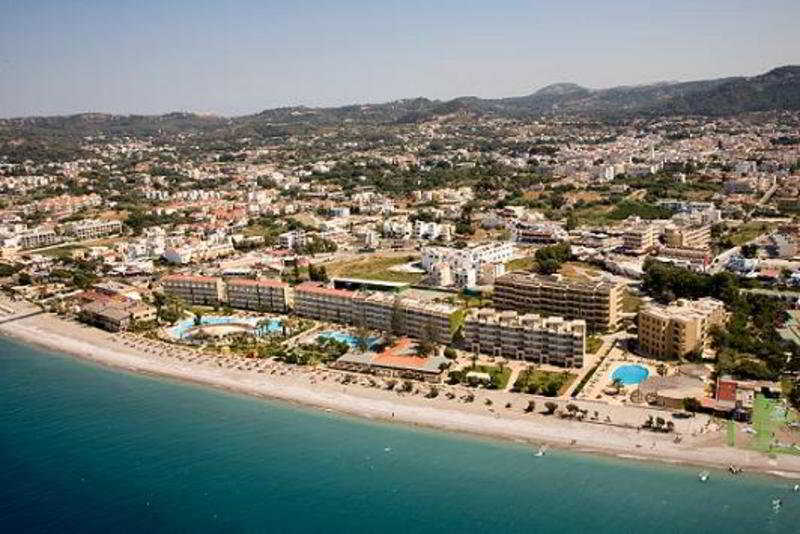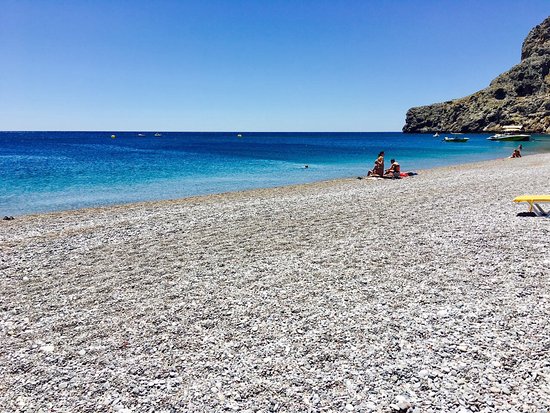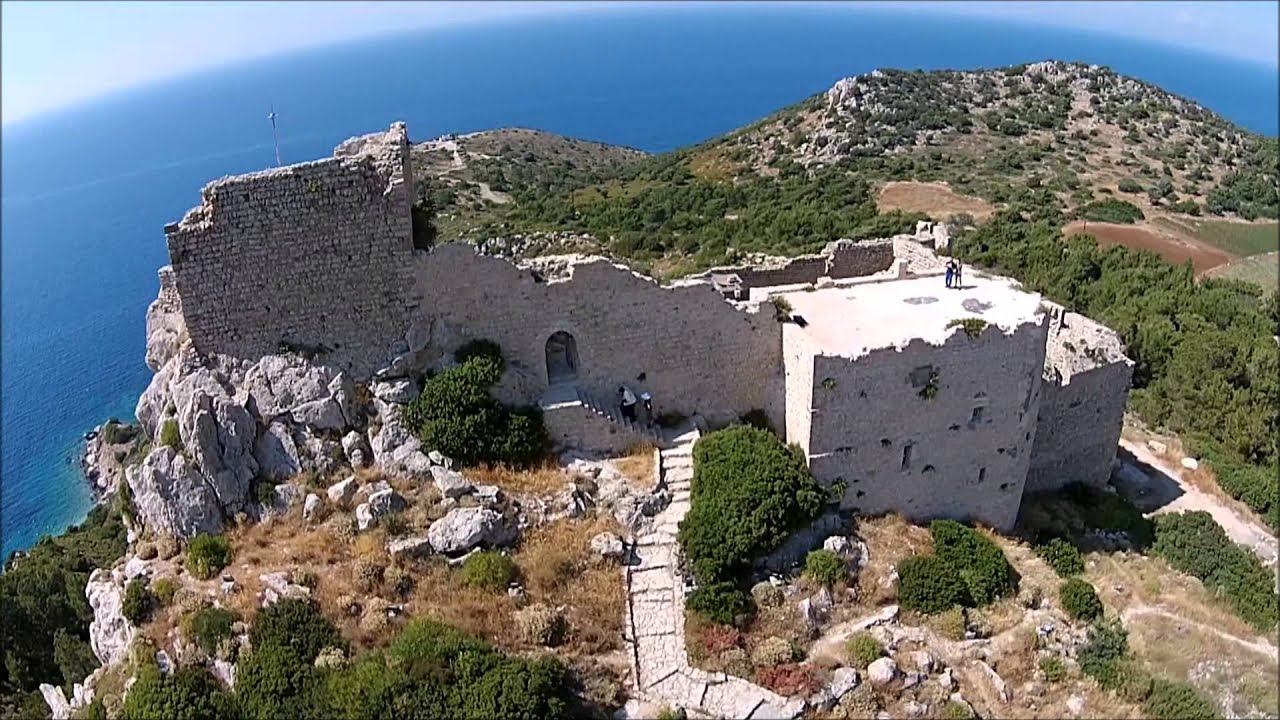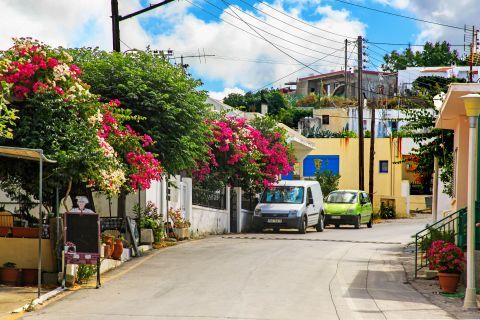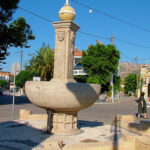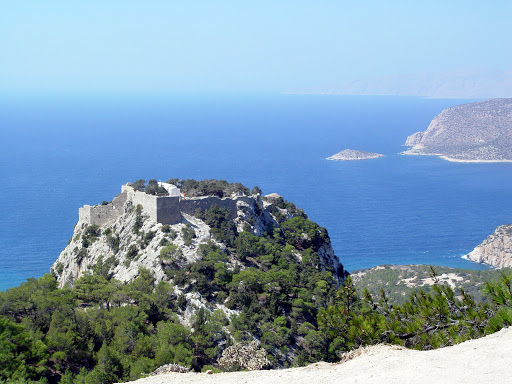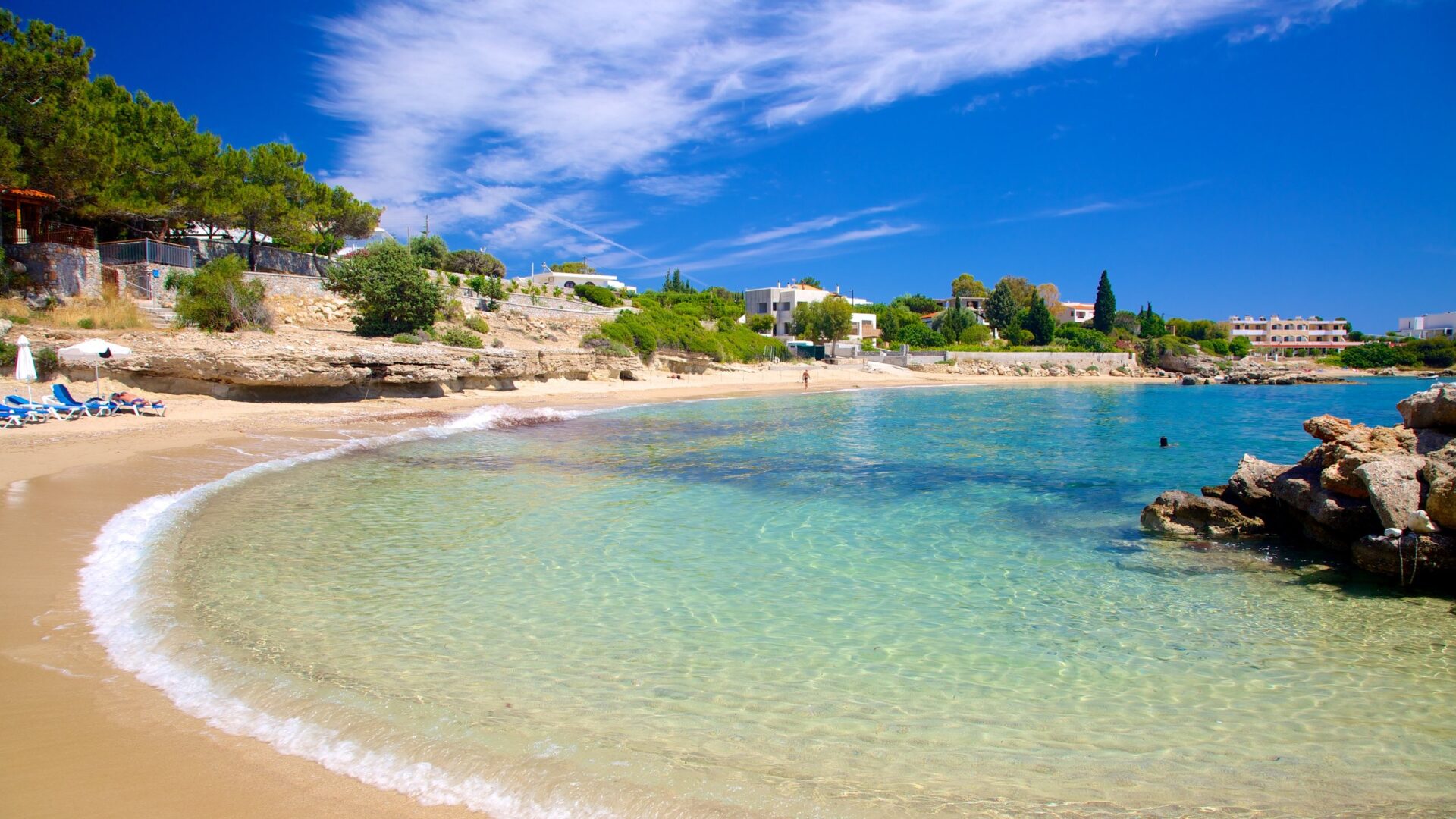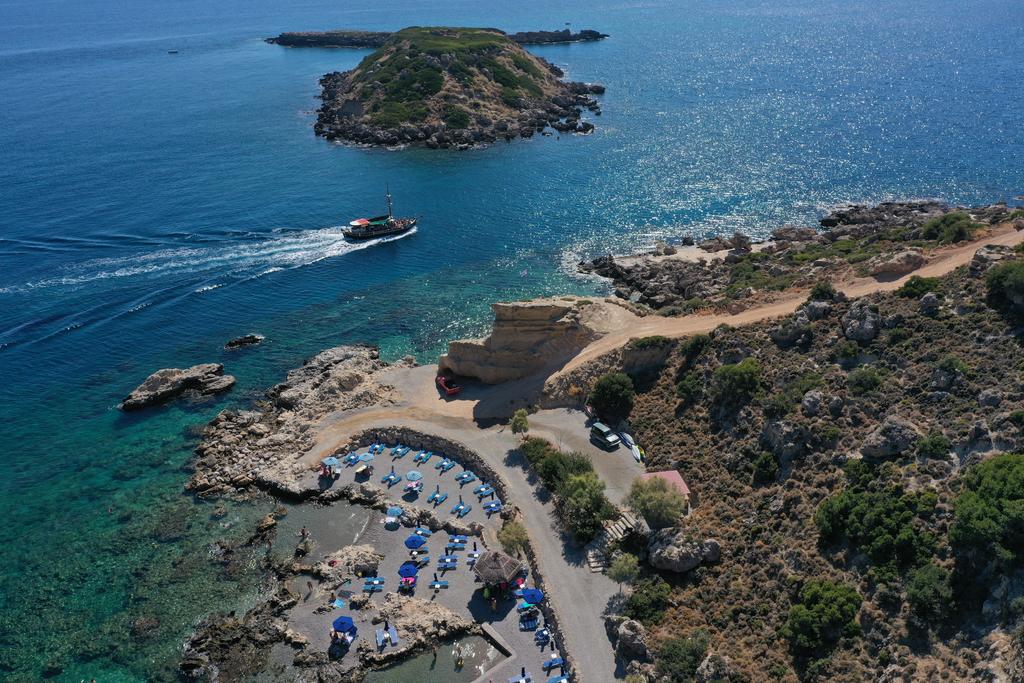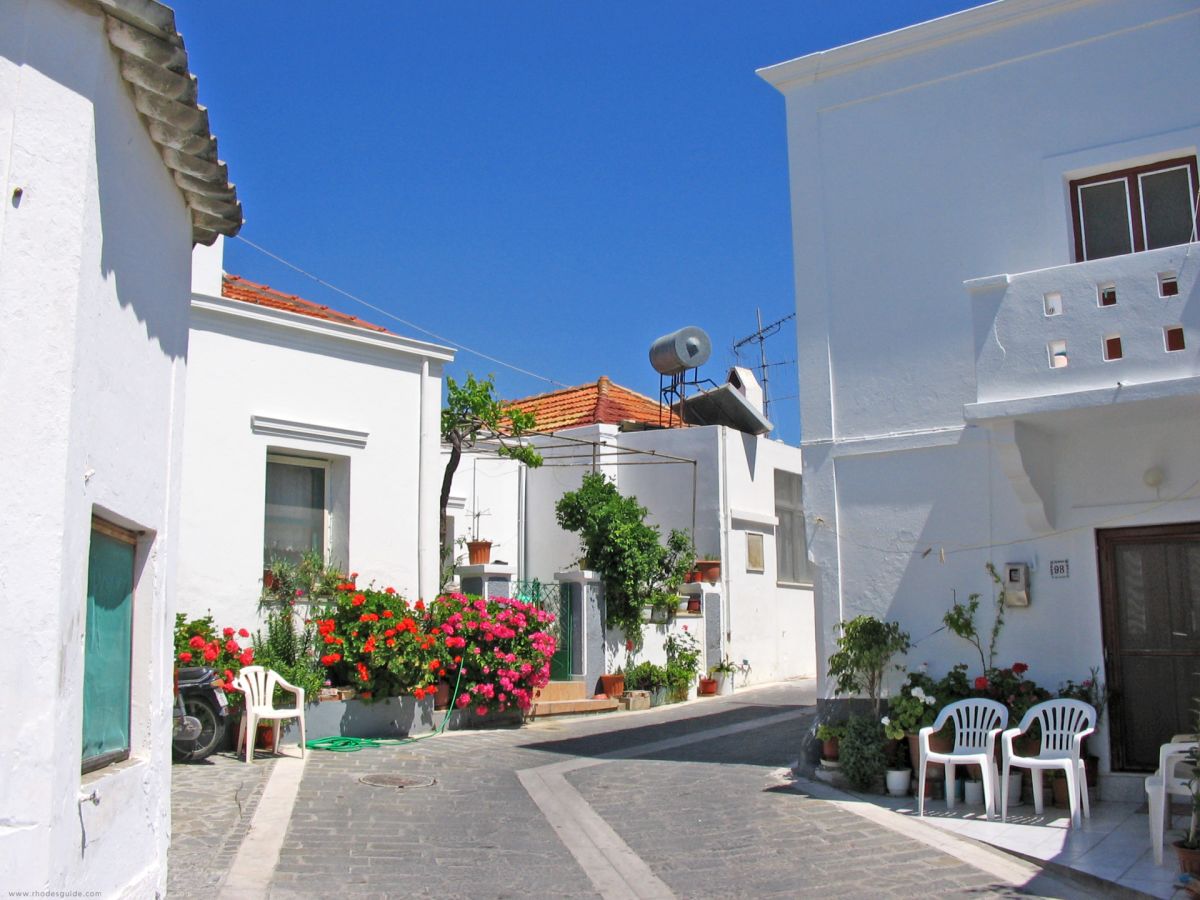
You are using the Free Edition of RhodesAPP. For extensive information on Rhodes, GO PRIME with our comprehensive Greek Travel App featuring the full editions of Rhodes and 25 more Greek islands & Athens.
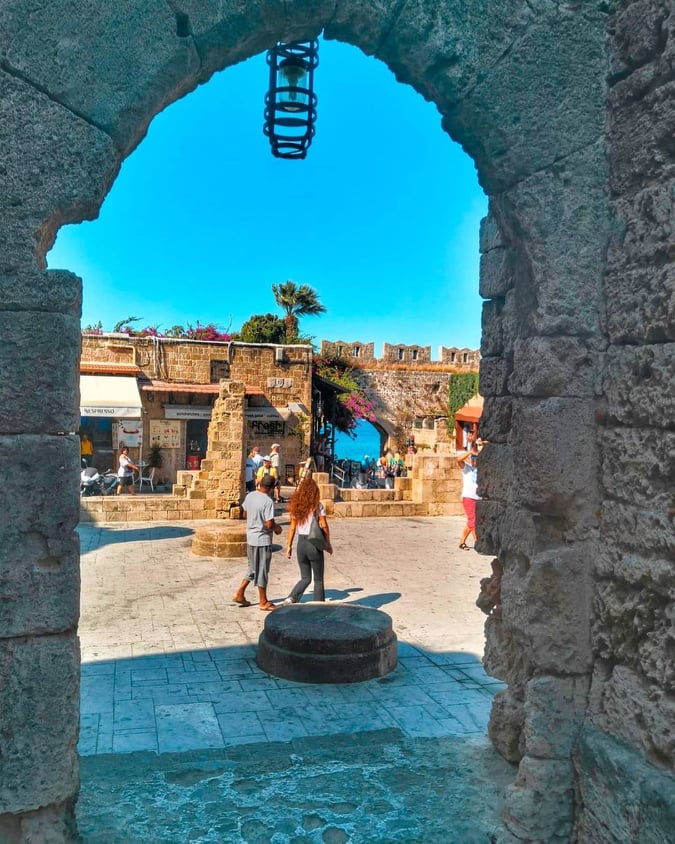
The island of Rhodes seems as if it was transported from another time and place. As the former headquarters of the Knights of Saint John, many of the old Medieval structures are still standing. Yet there’s so much more to the island. While you should certainly visit the old buildings that were part of the Knights’ complex, there’s still a lot to see beyond that. The towns and villages listed here all have plenty of options for how to spend your time while on the island.
RHODES TOWN
The biggest town on the island and the seat of the local government. The city is divided in two. The New Town with its modern buildings and shopping areas and hotel-lined beachfront, and within it sealed behind a double ring of high walls and a deep moat, the Old Town. Nearly half the population live in the area, with 6,000 living within the walls of Rhodes Old Town.
The Medieval section is a true gem in Greece, few cities can boast so many layers of architectural history, with ruins and relics of the Classical, Ottoman and Italian eras entangled in a mind-boggling maze of twisting lanes.
One of the best-preserved medieval towns in Europe, it is inscribed in the World Heritage List of UNESCO. Imposing stone-built buildings, paved alleys, cozy shops, restaurants and bars create a unique scenery and vividness in a living legend. Passing through one of the seven gates into the old-town, you move into a different world. Over 200 rambling, narrow, pedestrian-only streets wait to be explored, many without street names. Take the time to meander through these incredible streets and eat a great meal in a taverna or restaurant. Be sure to include a stroll down Knights Street, which takes you to The Palace of the Grand Master. Restored by the Italians in 1940 it holds an extensive collection of priceless antiquities. The Archaeological Museum includes a myriad of artefacts, as well as a small room housing Aphrodite of Rhodes. Climb to the top of the clock tower for photographic views across the city. Visit the port to watch the giant cruise liners nosing their way in and out, or enjoy a day relaxing on the beach.
As dusk falls, night-time restaurants, bars and clubs open up. With majestic buildings silhouetted against the night sky, the old-town takes on a new relaxed, even romantic ambience, ideal for those special occasion meals. If you want lively, then head for Orfanidou Street with its busy bars and clubs, where you can party into the early hours.
The New Town, meanwhile, is a modern Mediterranean resort, with decent beaches, upscale shops, lively nightlife and waterfront bars, cafes, restaurants and tavernas.
If you only have time to visit one place on the island, Rhodes Town should top your list. You can also stay inside the Old Town in one of the numerous hotels.
The local tourist information office for the Dodecanese Islands is located in Rhodes city at the corner of Makariou & Papagou Streets (opposite the New Market). ☎ +30 2241 410 44335 or +30 2241 410 44336.
LINDOS
Although Rhodes Town is one of the most recognisable places on the island, Lindos isn’t too far behind. In fact, many people prefer it here because it is much smaller and quainter. While much of Rhodes Town is taken up with the older Medieval buildings, Lindos is known for its quiet beauty and serene landscapes. This is the perfect place to visit if you want a relaxing vacation.
Lindos is both a picturesque town and archaeological site located approximately 58 km (36 mi) south of Old Town Rhodes and is a picturesque white settlement build on a huge rock overlooking the Aegean Sea. On the top of the cliff, the ancient Acropolis of Lindos dominates the setting, while the beach under the village is one the best bays in Rhodes. The Acropolis is absolutely amazing and is a must see if you’re looking for some of the best views in all of Rhodes. Note that the climb up to the Acropolis requires you to be somewhat active and able to climb stairs, lots of them. The trail begins through town and slowly but surely starts to get steeper as you climb the hill towards the Acropolis. Once there, you’re rewarded with the ancient site dating back to 300 BC. More information on the Lindos Acropolis can be found under ATTRACTIONS.
KALLITHEA
Kallithea village includes a quiet beach area and thermal springs and is popular with the locals. It is is just eight kilometres down the east coast from the Island’s capital, and three kilometres north of Faliraki.
For centuries the thermal springs of Kallithea attracted people from across the islands and farther afield, looking for cures for their various ailments. In 1928, the Italians constructed the first building to enclose the springs, but it wasn’t too long before they dried up, and the project was abandoned. In the late 1990s however, work began to restore the spa building back to its original splendour. After many stops and starts the job was finally completed, and the Moorish style spa re-opened in 2007. Today, you can visit the spa with its Rotunda Hall, imposing entrance-way and patio, beautiful pebble mosaics, and gardens full of palm trees, pine trees, and local flora; but the healing waters will be the warm salt water of the Aegean Sea. Kallithea’s sand and shingle beach is well equipped with sunbeds and parasols, and offers a range of water sports, with scuba-diving being particularly popular. There are also several boat trips which run from the beach. The nightlife is pleasantly subdued and ideal for those who want to enjoy evenings with a quiet meal and glass of local wine, or relaxing with a beer on the terrace of a local taverna.
FALIRAKI
What a difference three kilometres makes. From the quiet laid back atmosphere of Kallithea, to one of the main spots for partying in Rhodes. Welcome to Faliraki – Rhodes’ action resort. However, with its days of being the 18-30 party destination of the Greek Isles long gone, Faliraki has morphed into a resort to suit all ages and tastes. Today Faliraki’s nightlife caters for all ages and tastes, with local and international restaurants, fast-food outlets, and a whole range of family bars catering for everything from background music, to karaoke, and live music venues. For those in party mood, head for Club Street and Bar Street, and prepare to party ‘till dawn.
Falirakis main sandy beach stretches five-kilometres along the coast, and with a gentle slope into the sea, young children can safely play around the shore, while teenagers, mums, and dads can try their hand at every type of water sport you can think of. If you like beach time, but busy-busy doesn’t do it for you, there are three smaller beaches close by, although in the height of the season even they can get busy. Boat trips ply their trade throughout the day from the small harbour or off the beach. For lunch you can frequent one of the beach bars, or stroll the promenade and enjoy a snack in the shade on the terrace of one of the many tavernas and cafes that stretch along the front.
AFANDOU
The village of Afandou was founded during the time when pirates used to overrun the islands of the Mediterranean and inhabitants sought shelter inland. The village of Afandou took its name form the word ‘áfandos’, which in Greek means ‘invisible’, because it could not be seen from the sea. Afandou is located 5Km from Faliraki, and is one of the largest and oldest villages on the island. Set against a lavish setting of fruit and olive trees, the village is also famous for its carpet manufactures. During the summer months the village is connected to the long beach – over 3Km of beach – by small a road-train.The golf course of Rhodes is situated in this area.
APOLLONAS
Named after the Temple of God Apollon, who was the protector of Rhodes Island and fine arts, back in time, this village is well-known for its Folkloric Museum and historic olive press, along with the equipment used to produce the olive oil. In the Museum you will also find traditional women’s costumes and household utensils.The church that you will find next to the museum was built using the remnants of the ancient temple of Apollon. Apollonas is an olive producing area, so be sure to taste the wonderful olive oil produced here during your visit.
ARCHANGELOS or (Arhangelos)
The second largest town on the island, Archangelos can be found south of Rhodes Town and has an excellent location on the eastern coast of the island. It is the ideal place to visit if you want to spend a lot of time at the beach soaking up the sun! After a day at the beach, don’t forget to spend some time enjoying the nightlife and eating in some of the delicious restaurants and tavernas! Also, be sure to stop in on the Church of the Archangel Michael to view its impressive architecture.
ASKLIPIOS (Asklepieion)
In the southern part of Rhodes you can find the small inland village of Asklipio. It features a superb Byzantine church and a medieval castle. The heart of the village is the square in front of the Church of the Dormition. Take a look at the interior of the church, which was built in 1060 and has been recently restored to admire the extraordinary fine Byzantine wall paintings. Just next door in the church’s old olive press, you will find a small folklore museum. After visiting the church, take the road up to the castle. At the top of the hill the medieval fortifications offer a marvellous view of the beach stretching endlessly from Kiotari all the way to Gennadi.
EMBONAS
Embonas village is the highest village on Rhodes and is located at an altitude of 850 meters on Attavyros, the only mountain of the island (altitude 1.215 meters). On the top of Attavyros you will find the remains of a temple dedicated to Zeus, built by the first King of Crete at the Minoan Period. You should know that this is not just the reason to visit Embonas. In the streets of the village you will discover houses that are a fine example of the traditional architecture of Rhodes. The place is almost untouched from tourism and completely unscathed. In addition to that, you will find many inhabitants still wearing local costumes. You are entering a village where the local customs and traditions are still upheld, passing from one generation to another. If you are lucky and are will be able to visit the village during the wine festivals, you will enjoy traditional songs played by local musicians and local dances performed by young men and women. The events of the wine festivals are complimented by various cultural events, such as plays, exhibitions, traditional product markets and traditional parties.The visitors, locals or not, are also offered local grape must pudding called “moustalevria” or “matsokofti” in the local dialect.
GENNADI
Gennadi, around 64 km from Rhodes Old Town and fairly close to Prasonisi, attracts many surfers due to its ideal weather and surf conditions. Gennadi only started developing in the last decades and the main coastal road along the beach is lined with hotels and villas. If you are looking for some adventure, take the opportunity to explore one of the many seculded beaches stretching along the sandy shore from Gennadi to Prasonisi. It is one of the few unspoiled stretches of coastline still left on Rhodes.
HARAKI (Charaki)
A small former fishing village located next to Lindos, most visitors call Haraki ‘Heaven on earth’. And there is ample reason to believe so. Surmounted by the ruins of the Feraklos fortress, the resort of Haraki (or Charaki, 8 km south of Archangelos) extends around a semicircular bay lined with quaint tavernas, cafes, restaurants, mini-markets and a foreign press agency.
IXIA
Ixia is a hotel beach resort, one of the most cosmopolitan on the island on Rhodes, and an extremely popular choice with those seeking high-quality accommodation near the town of Rhodes. There are water sports centres where you can rent windsurfing and surfing boards, as well as jet skis. Basically Ixia is a series of adjacent beaches rather than one single beach, most of them organised and operated by the seafront hotels. Some sections are public and others are private.
KOLYMBIA
Around 15 kilometres to the south of Faliraki is relatively new when compared too much of the Island of Rhodes, Kolymbia Village. It was built in the 1920s by the Italians, when they were endeavouring to colonise the island. Kolymbia has increased in popularity with visitors since the 1990s, and large grand hotels now take up much of the skyline. Even so, the planners have made sure this natural, rugged coastal area loses none of its essential appeal. A resort popular with couples, young families, and seniors, it is the ideal venue if you want to spend your holiday in a totally relaxing atmosphere. Wherever you stay in Kolymbia, a stroll along the main street, Eucalyptus Avenue, will lead you to Afandou Bay, and Kolymbia’s narrow, but very attractive beach. With cliffs rising from the sea, and a shallow foreshore, it is a safe beach for children of all ages. To add a little variety to your day, several different boat trips are available from the beach, as well as a selection of water-sports. If you want to explore a little farther afield, hiking and mountain-biking options are available, or you can book a guided tour.
KREMASTI
Kremasti is a well-developed tourist resort which beautifully combines neoclassical and modern architecture. It boasts great tourist facilities, with wonderful food, accommodation and shopping options. Don’t miss seeing the remains of the Medieval castle and the impressive church of Virgin Mary.
LARDOS
Village life is centred around the wide tree lined Lardos village square of this charming village. You will find many of the friendly locals enjoy sitting in the cafes (kafeneia) on the square, drinking Greek coffee or the local ouzo, while talking and playing backgammon (tavli). The numerous local restaurants offer a variety of mouth watering selections of both Greek and international cuisines. By day, organized excursions are available to Lindos Village, and the Acropolis of Lindos, trips around the island, shopping trips to Rhodes Town, to the ruins at ancient Kamiros and the Monasteries.
MONOLITHOS
Located on the southern side of the island, 80 km from Rhodes Town, Monolithos is one of the most impressive villages on Rhodes. Whitewashed courtyards with brightly-coloured geraniums, stone houses with tile roofs looking out over the waves, the rocks with the medieval castle built by the knights in the 15th century at their peak, windswept deserted beaches for frollicking in the waves and a landscape of unspoiled beauty – the magificence of Monolithos difficult to find elsewhere on Rhodes.
PEFKOS
A smaller tourist resort close to Lindos which originally started as a small collection of farms and private residences. With its golden sandy beaches sloping gently into the crystal clear waters of the Aegean and spread along the coast at the foot of the pine clad Marmari hillside, Pefkos is a favourite summer retreat for Lindians and Rhodians alike.
PSINTHOS
This village is named after its springs and plane trees. The well known spring of Fasouli is here, and it is a wonderful place for enjoying the beauty and quietness of nature. While here, you simply must sample the revered local cuisine, particularly their famed meat dishes, locally produced wines and high quality honey from local producers. The taverns in Psinthos specialise in grilled meat. Life centres around the village square where you can see folk just sitting back and to use a well known phrase, “watching the world go by”. Psinthos is famous as the site of the last battle between the Turks and Italians.
STEGNA
If absorbing local culture and lifestyle plays a big part in your holiday enjoyment, then a stay in Stegna may provide it all. This fabulous secluded resort on the east coast is the beach area of the village of Archangelos, just 500 metres inland from the front. It is a resort popular with locals, visiting families, and seniors, although no matter what your age, if you enjoy laid back with a village vibe, it is worth serious consideration. Before the days of mass tourism, Stegna was a popular stop-over for many of the young adventurers and backpackers making their way around the Greek Isles. Today, the sand and shingle beach stretches for around two kilometres, although part of it is taken over by the only large hotel in the area, as a private beach for its guests. At the beach, large boulders rise out of the water close to the shore, forming rock pools which will keep the youngsters and their shrimping nets happy for hours. Those wanting to explore the deeper areas of the pools can buy snorkels, while other water-sports activities are available on the beach, and tour boats offer various trips to different islands. Along the beachfront walkway, traditional tavernas offer cool refreshing beers and wine, while local restaurants provide classical Greek dishes, and the freshest of locally caught fish. Accommodation-wise, there is just the one large commercial hotel, or you can choose from several smaller family owned hotels, guest houses, self-catering villas, apartments, and rooms to let, where you’ll be welcomed with open arms.
STEGNA
If absorbing local culture and lifestyle plays a big part in your holiday enjoyment, then a stay in Stegna may provide it all. This fabulous secluded resort on the east coast is the beach area of the village of Archangelos, just 500 metres inland from the front. It is a resort popular with locals, visiting families, and seniors, although no matter what your age, if you enjoy laid back with a village vibe, it is worth serious consideration. Before the days of mass tourism, Stegna was a popular stop-over for many of the young adventurers and backpackers making their way around the Greek Isles. Today, the sand and shingle beach stretches for around two kilometres, although part of it is taken over by the only large hotel in the area, as a private beach for its guests. At the beach, large boulders rise out of the water close to the shore, forming rock pools which will keep the youngsters and their shrimping nets happy for hours. Those wanting to explore the deeper areas of the pools can buy snorkels, while other water-sports activities are available on the beach, and tour boats offer various trips to different islands. Along the beachfront walkway, traditional tavernas offer cool refreshing beers and wine, while local restaurants provide classical Greek dishes, and the freshest of locally caught fish. Accommodation-wise, there is just the one large commercial hotel, or you can choose from several smaller family owned hotels, guest houses, self-catering villas, apartments, and rooms to let, where you’ll be welcomed with open arms.
THEOLOGOS or (Tholos)
Are you looking for an escape from the bustling holiday life? If so, the beautiful traditional village of Theologos is the place to be. Located just 22 kilometers from Rhodes Town, Theologos also makes for a nice day trip. You won’t want to miss the chance to observe the beauty of the surrounding area and also visit the Monastery of Kalopetra.
